| 1 | Oaxacan coral snake |
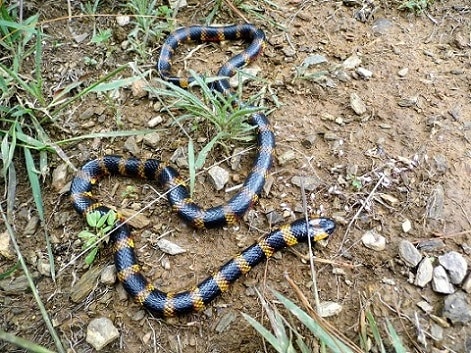
This coral snake has a small territory, but is highly concentrated within that territory. The Oaxacan coral snake lives only in southern Mexico, in its namesake Oaxaca state, and doesn’t come close to the Guatemalan border. This is a relative short species, at an average of 45cm, and a maximum of 92cm.
The unique physical characteristic of Micrurus ephippifer lies with its red bands. The species officially has a red-yellow-black-yellow-red pattern identical to the eastern coral snake of Florida. But each red scale has a black marking, giving it a unique appearance. In some snakes, the black covers more red than others, while in a few, the black takes over the red so fully that it’s barely visible. See the image above. This image, meanwhile, shows a more typical example.
The Oaxacan coral snake has been found up to 2300 metres above sea level. They live in dry scrub in rolling foothills, tropical deciduous forests and pine-oak forests at higher elevations. Its venom is a mystery. The Oaxacan coral snake is almost certainly neurotoxic like its fellows, but the precise toxins and severity are yet to be researched.
| 2 | Venezuelan coral snake |
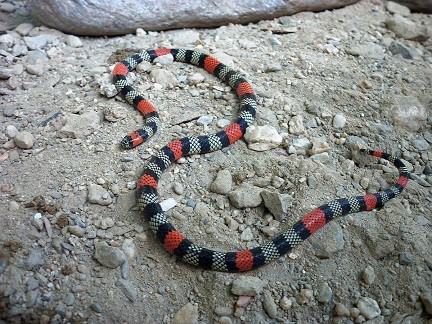
This species lives in northern South America, with no spillage into Central America. Micrurus isozonus lives exclusively east of the Andes, in Venezuela, Colombia and far northern Brazil. In 2002, it was discovered in Guyana for the first time.
This is a longer coral snake species at a maximum of 150cm. When disturbed, it performs a defensive display of raising its tail high in the air, swishing it from side to side, and hiding its head and precious brain beneath coils. Venezuelan coral snakes stick to humid habitats, including forests. However, they’re a relatively flexible species which appears in urban areas, even the Venezuelan capital Caracas, sometimes in vacant lots under rubbish. This is the most common venomous snake in Caracas.
According to a 2011 study, this coral snake is slightly milder than the eastern coral snake, achieving an LD50 score of 0.52-0.61mg versus 0.32mg. Its venom is neurotoxic, but less commonly for a coral snake, has haemolytic properties. It is capable of blocking factor X and platelet aggregation, key ingredients in the blood clotting recipe. Fellow snakes are confirmed in the Venezuelan coral snake’s diet, including Leptotyphlops blind snakes, and Erythrolampus bizona.
| 3 | Steindachner’s coral snake |
A mysterious coral snake of Ecuador, with the first trickles of information arriving just recently. This species lives in eastern Ecuador and northeast Peru. It lives to the east of the towering Andes mountain range, and is hence completely missing from western Ecuador. The pattern of this coral snake is red-yellow-black-yellow-red. It overlaps in Ecuador with a fellow coral snake, the ornate coral snake (M. ornatissimus), but Micrurus steindachneri has significantly longer red bands than black.
Steindachner’s coral snake is most common in pristine rainforests on Andes mountain slopes. They also appear in gardens, plantations and clearings on the borders of forests. It’s a relatively rare species which correlates closely with humidity and high rainfall. Micrurus steindachneri is assumed to be neurotoxic, but only one recorded bite case exists. A 46 year old woman experienced surprisingly mild symptoms, including pain and swelling.
This poorly researched species now has a handful of confirmed prey: Boulenger’s largescale lizard (Alopoglossus brevifrontalis), and the neighbouring Ecuadorian species the decorated coral snake (Micrurus decoratus). Steindachner’s coral snakes have been spotted resting on leaf litter, bare soil, and in puddles, often immediately after heavy rain.
| 4 | Bolivian coral snake |
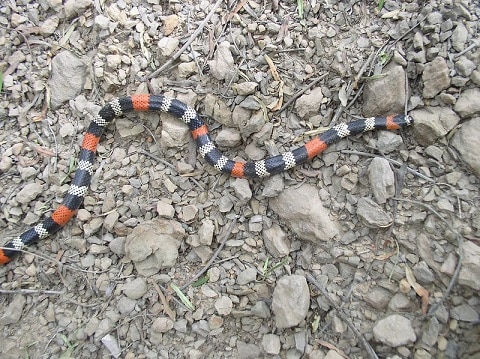
This rarely sighted snake may be found only in Bolivia, as that’s where all sightings have been recorded. Rather than humid rainforests, Bolivian coral snakes live in dry valleys in the Andes foothills. They reach high altitudes; the limit was originally said to be 2150 metres, before being revised 600 metres upwards to 2750 meters in 2007. This snake was found lurking under a rock, in a dry, sandy area with little vegetation and only a handful of trees dotted around. The area was one used heavily for agriculture, with potatoes, corn and wheat fields. The habitats of the Bolivian coral snake are completely different to most of its family.
This snake has similar colours to the Venezuelan coral snake, but with more evenly spaced bands. The red is only slightly longer than the rest. One recognisable sign is a mostly black head from above, but with a pale stripe crossing the snout. Bolivian coral snakes reach a maximum (so far) of 82.2cm.
This species is a confirmed snake-eater, having sworn itself to the dark arts of ophiophagy long ago. Confirmed snakes in its diet include the blind snake Epictia striatula, ringed hognose snakes (Xenodon semicinctus) and a Harvey’s blackhead (Apostolepis multicincta), another snake found exclusively in Bolivia.
| 5 | Avery’s coral snake |
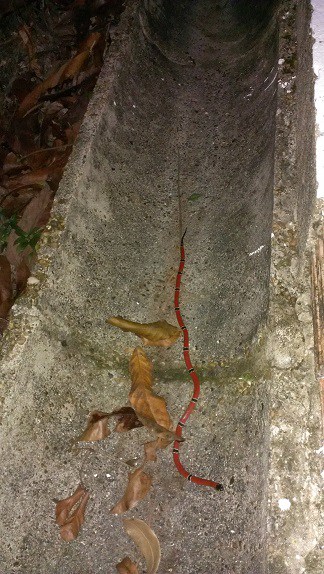
One of the most easily recognisable coral snakes. Avery’s coral snake inhabits a small area of northern Brazil, crossing the borders into Guyana and Suriname, mainly in humid lowland forests up to 800 metres. Its patterns are red-white-black-white-red, but this doesn’t fully explain its appearance. In Micrurus averyri, the white bands are extremely thin, and the black not much thicker, creating 3 incredibly tightly packed bars. The red then covers a vast area, far vaster than others.
Micrurus averyri looks closest to the painted coral snake (Micrurus corallinus) of southern Brazil, but it also has a jet black head, and a jet black tail interspersed with occasional thin white stripes. In some images, its head almost looks like steel. In fact, “black-headed coral snake” is another of its names.
One confirmed bite happened to a 7 year old girl in Presidente Figueiredo municipality, Brazil. She was bitten on the foot outside the front door of her house, in an urban area surrounded by forest. She reached the hospital 15 minutes later, and soon experienced swelling stretching all the way up her leg, pain, and paraesthesia (tingling). She also experienced nausea and drooling. While relatively mild, this suggests a venom combining neurotoxins with cytotoxins.
| 6 | Carib coral snake |
A little researched coral snake, which lives in southeast Colombia, Venezuela, French Guiana, Suriname and far northern Brazil. It overlaps with the Venezuelan coral snake, yet is easily distinguishable, featuring alternating black and gold bars, with barely a hint of the usual red. Carib coral snakes measure 45-60cm and are mainly found in humid lowland forests, but also moist meadows near streams.
Like other coral snakes, Micrurus psyches has a small mouth and struggles to bite large surfaces. One of the only confirmed bites happened to a man’s thumb, in the Saint-Laurent-du-Maroni area of French Guiana. The Carib coral snake initially tried to bite his shoe, failing several times. The man rapidly removed the snake, but was soon experiencing painful numbness of his left hand. Rarely for a coral snake, it had cardiotoxic effects, causing first-degree atrioventricular block and elevated T-waves under an electrocardiogram.
While mild, the neurotoxic effects took over a month to completely heal, with lingering numbness in the thumb. This is the only detailed description of a Carib coral snake bite to date.
| 7 | Capuchin coral snake |
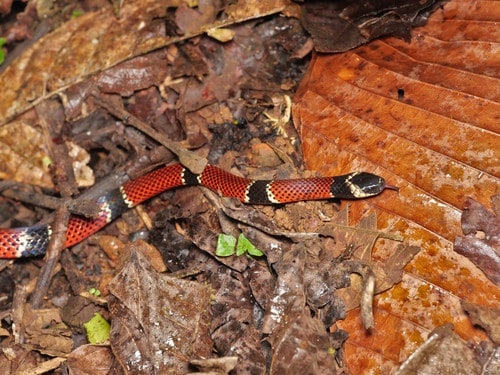
A coral snake of far northwestern South America. Unlike most species, which are blocked by the skyscraping Andes mountains, this species manages to cross them, hence the alternative name of Trans-Andean coral snake. It lives in western Ecuador, Colombia, and in 2015, one was discovered in central Panama, extending its territory westwards by several hundred miles.
Capuchin coral snakes average at 50cm and have a red-yellow-black-yellow-red pattern. A signature feature is red scales overlaid with fine black markings, combined with a black head with a yellow neck collar. In tests on mice and rats, its venom had a variety of effects: neurotoxicity, swelling, and myotoxicity (muscle damage).
Micrurus dumeril is mainly a forest dweller, sticking to moist/wet forests. Most of its range is at altitudes of 0-600 metres, but in the Andes mountains it has been found at 2133 metres. This snake is often found slithering slowly and patiently across a bed of fallen leaves. Diet reports are sketchy, but a confirmed prey is the Thomson’s caecilian, which it was observed eating in Colombia in 2017, at an altitude of 217 metres. Swamp eels and fellow snakes are also confirmed prey. The Capuchin coral snake reaches a record length of 95.4cm.
| 8 | Roatan coral snake |
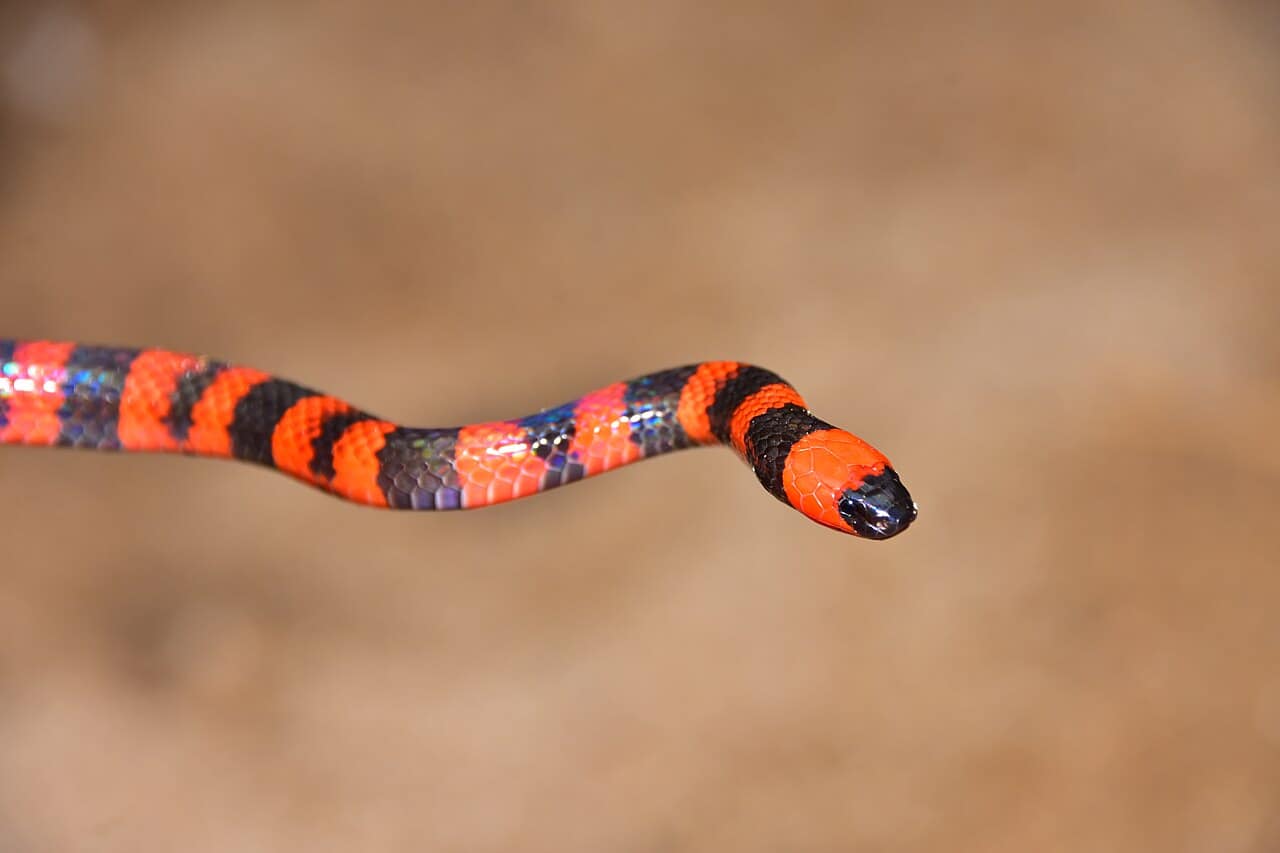
The only coral snake endemic to a small island. Micrurus ruatanus is found exclusively on the island of Roatán off the north coast of Honduras, in the western Caribbean sea. Several other endemic species live on this tourist hotspot: the Roatán Island agouti, the Roatán longtail snake, yellow vine snake, etc. It’s possible that Caribbean pirates once stumbled onto this island and were ambushed by the native coral snakes.
Micrurus ruatanus is the only venomous snake on the island. It’s found mainly in low woodlands ranging from 0 to just 20 metres above sea level. Micrurus ruatanus are particularly common under leaves of coconut trees, slithering slowly along the ground. Its confirmed prey include the black blind snake (Epictia magnamaculata), Bay Island least gecko, and golden spectacled tegu.
A 2019 study analysed its venom for the very first time. It found a high lethal activity in mice, and the usual three-finger toxins (standard issue neurotoxins), plus smaller quantities of metalloproteinases, serine proteinases, and L-amino-oxidases. Human development is intense in the centre of Roatán, and Micrurus ruatanus is now in the IUCN critically endangered category. Its remaining habitat is believed to encompass just 86 km².
| 9 | Small coral snake |
One of two coral snakes found on Trinidad. The small coral snake (Micrurus circinalis) is easily distinguishable from the Trinidad ribbon coral snake by its far thinner white rings, which are just one scale wide. Small coral snakes measure 40-50cm and are a relatively flexible species. They’re most common in humid lowland forests and woodlands, but also appear in adjacent urban areas and agricultural land.
This is a fossorial coral snake, spending time underground in burrows dug by other animals, usually in the top layer of soil, so that they can emerge and slowly prowl the forest floor at will. Micrurus circinalis preys on several other Trinidad residents, including three-lined ground snakes (Atractus trilineatus), Hallowell’s coffee snake (Ninia atrata), and each other. They also feed on insect larvae and marbled swamp eels.
This species isn’t found on Tobogo, and only has a tiny enclave on the South American mainland, in neighbouring Venezuelan. Small coral snakes and the ribbon coral snakes overlap heavily in Trinidad, but the ribbon version is more aquatic, and derives more meals from fish and amphibians.
| 10 | Anchor coral snake |
This Ecuadorian coral snake loves forested foothills, pristine rainforests, and sometimes forests heavily degraded by mankind. Anchor coral snakes are one of the longest species, reaching up to 151cm. They have a narrow, long spine of territory west of the Andes, including western Ecuador, western Colombia, and possibly eastern Panama. It mainly lives below 1500 metres, but has been found at 2300 metres in Colombia. Its venom is confirmed to contain the usual paralysing alpha-neurotoxins.
The anchor coral snake is a classic triad species. The patterns here are red, followed by 3 black rings and two white sandwiched inbetween. This layout is pretty common, but the distinguishing feature with Micrurus ancoralis is a fully red face. This makes its beady black eyes stand out all the more clearly.
Micrurus ancoralis seems to love elongated prey. Confirmed meals so far include the legless speckled worm lizard (Micrurus ancoralis), and Hallowell’s coffee snake, which is also eaten by the small coral snake. They climb vegetation occasionally, but usually stick to the ground, whether crossing roads at night or slithering over dense beds of fallen leaves. Like most of this list, the anchor coral snake has very little research to its name.
